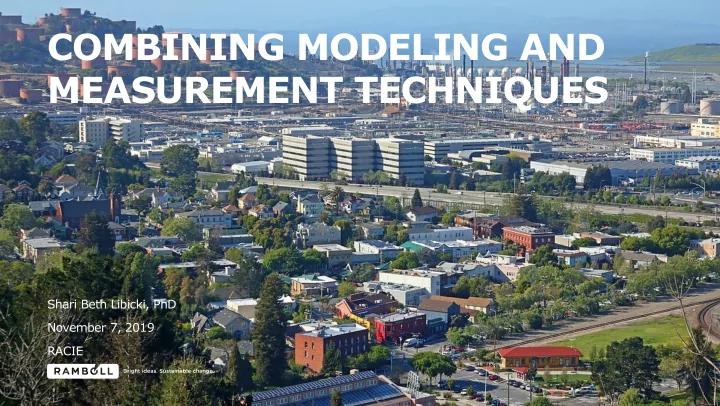

COMBINING MODELING AND MEASUREMENT TECHNIQUES Shari Beth Libicki, PhD November 7, 2019 RACIE
FACILITY SCALE
EPA STATE AND TRIBAL GRANT • The City of Richmond along with the Bay Area Air Quality Management District (BAAQMD) established a three-year community air monitoring program to monitor emissions from the Chevron Refinery. • As a part of the United States Environmental Protection Agency (US EPA) State and Tribal Grant (STAG), Ramboll will apply modeling and numerical analysis techniques to determine whether the complex dataset can be used to infer or estimate emissions from the Refinery. • The goals of the project are: • Make use of a rich data set that has previously been under-utilized • Evaluate covariation within all pollutants measured to allow a reduction in parameters measured. • Evaluate whether a combination of data analytics and dispersion modeling with US EPA’s AERMOD model can determine distinct sources of emissions from the refinery to use monitoring to measure emissions
A RICH DATASET? • Three open-path fenceline monitors and three multi pollutant community monitors (CMS) • Measures Hazardous Air Pollutants, Criteria Air Pollutants, Hydrocarbons including Benzene, Hydrogen Sulfide (H 2 S), Sulfur Dioxide (SO 2 ), Volatile Organic Carbon and many more. • Chevron operates GLMs by permit • How can the data be better used?
DATA COMPLETENESS “Completeness” only includes data above detection limit. • Only pollutants such as Ammonia, Black Carbon (BC) and Particulate Matter (PM) have a high degree of • completeness at the community monitors, but several confounding sources of BC and PM in the area.
ONLY ONE POLLUTANT CONTAINED ENOUGH VARIABILITY • Chevron provided ground-level measurements (GLM) of H 2 S and SO 2. • Air District provided daily emissions data as measured in the Continuous Emissions Monitoring System (CEMS). • GLM and CEMS data are more complete for 2016/2017 compared to fence-line/CMS. Dataset Field FCC SRU Train 1 SRU Train 2 SRU Train 3 2014 2015 2016 2017 2014 2015 2016 2017 2014 2015 2016 2017 2014 2015 2016 2017 Chevron – SO2 1 Hr Avg (ppm) N/A N/A 99% 99% N/A N/A 86% 94% N/A N/A 89% 93% N/A N/A 77% 88% CEMS SO2 Emissions Rate N/A N/A N/A 99% N/A N/A N/A 100% N/A N/A N/A 100% N/A N/A N/A 100% Golden Gate Gertrude Castro San Pablo Dataset Field 2014 2015 2016 2017 2014 2015 2016 2017 2014 2015 2016 2017 2014 2015 2016 2017 Chevron - SO2 1 Hr Avg (ppm) 40% 97% 99% 88% 42% 81% 87% 96% 42% 100% 100% 100% 33% 91% 91% 94% GLM • SO 2 offers most complete dataset; few confounding sources of SO 2 in the area including a sulfuric acid manufacturing plant and the Richmond terminal. • Using supervised machine learning algorithm to predict SO 2 emissions from the refinery on an hourly basis based on features, including but not limited to meteorological data, dispersion coefficients and monitoring data.
CITY SCALE
BACKGROUND AB617 Funds community level air measurement, education, and emissions reductions Targets disadvantaged communities AB617 Funded Project in Richmond, CA (“Air Rangers”) Fill PM and NO 2 monitoring gaps Understand the refinery’s impact Communicate actionable data to the public in near- realtime Facilitate healthy outdoor recreation Local work force development for disadvantaged youth SB 535 Disadvantaged Communities
AIR RANGERS COMMUNITY AIR PROTECTION GRANT Action Plan Team of City, NGOs, scientists Site 50 PM & NO 2 sensors; take 70 toxic metals samples Communicate hyper-local air quality to the public, hourly Hourly hotspot ID and source attribution
SENSOR NETWORK IN RICHMOND • Network of up to 50 low-cost Clarity sensors • Pollutants: PM 2.5 , PM 10 , and NO 2 • Sited in greenways, parks, and near high traffic roadways, and industrial centers Groundwork Richmond Air Rangers
Ramboll Shair
Ramboll Shair Nowcast Data Timing
COMMUNICATING RESULTS Web/phone app for Richmond is being developed
WHERE CAN DATA-DRIVEN MODELS ADD VALUE THAT FENCELINE SYSTEMS MAY MISS? • Spatial variation affecting people where they live and spend time
SHAIR OUTPUT WILL BE USED BY STAKEHOLDERS Groundwork Richmond T argeted tree planting as an air pollution intervention City of Richmond Integrate hourly Shair output into the City’s web data dashboard Investigate air quality data-driven land use planning activities Communicate information to the public in near-realtime Richmond citizens Engage with their environment Plan healthier outdoor activities T ake precautionary actions during localized pollution events Richmond-San Pablo Community Air Monitoring Steering Committee Identify major emissions sources Inform their official Community Emissions Reduction Plan (December 2020) Source Allocation?
HOW CAN SOURCE ALLOCATION BE MOST EFFECTIVELY USED? • Continuous feedback and comparison of model and measurement every hour helps us learn where model and measurement consistently disagree, pinpointing hotspots we don’t know exist or errors in our Air Quality Air Quality Emissions emissions inventory so we can improve Monitoring Modelling Inventories source allocation over time • Used by: • Community? • City? • District?
THANK YOU Shari Beth Libicki, PhD + the Shair Team slibicki@Ramboll.com
Recommend
More recommend